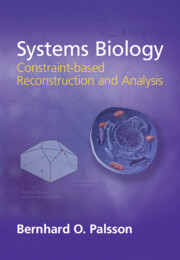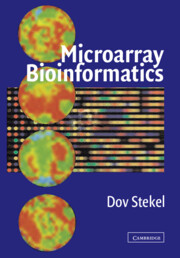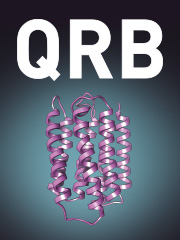Systems Biology
Recent technological advances have enabled comprehensive determination of the molecular composition of living cells. The chemical interactions between many of these molecules are known, giving rise to genome-scale reconstructed biochemical reaction networks underlying cellular functions. Mathematical descriptions of the totality of these chemical interactions lead to genome-scale models that allow the computation of physiological functions. Reflecting these recent developments, this textbook explains how such quantitative and computable genotype-phenotype relationships are built using a genome-wide basis of information about the gene portfolio of a target organism. It describes how biological knowledge is assembled to reconstruct biochemical reaction networks, the formulation of computational models of biological functions, and how these models can be used to address key biological questions and enable predictive biology. Developed through extensive classroom use, the book is designed to provide students with a solid conceptual framework and an invaluable set of modeling tools and computational approaches.
- Reflects the very latest developments in systems biology, explaining how quantitative and computable genotype-phenotype relationships can be built using a genome-wide basis of information about the gene portfolio of a target organism
- Developed through extensive classroom use to provide a solid conceptual framework in addition to an invaluable set of modelling tools and computational approaches
- The accompanying website features detailed lecture slides, along with MATLAB® and Mathematica® workbooks allowing hands-on practice with the material
Reviews & endorsements
'One of the defining challenges of systems biology is to determine the structures and mechanisms by which complex networks of genes, proteins and metabolites control cell processes and molecular dynamics. Bernhard Ø. Palsson is a leading pioneer in constructing and analyzing genome-scale models of such networks. Here Palsson offers students an insider's guided tour of the concepts, principles and techniques underlying this emerging field. The book is brilliantly laid out and offers professors well-structured, much-needed material for a graduate-level course in systems biology and network science.' James J. Collins, Massachusetts Institute of Technology
'This is a real tour de force. With enormous clarity, Bernhard Ø. Palsson sets out the what, why and how of network and systems biology, and of the important role of genome-wide reconstructions - especially, to date, of metabolism - in realising it … this is a masterful survey of the field by one of its leading practitioners. The development is nicely logical … If you are interested in network biology at all, then this book is for you.' Douglas Kell, University of Manchester
'Systems Biology is an excellent resource for familiarizing researchers and students with the process of reconstructing genome-scale metabolic models and the types of data needed. A number of thorough studies are included that shed light on a range of queries that genome-scale models are well suited to answer. In addition to models, a number of algorithmic techniques are described for analyzing models and inferring organizational principles of metabolism or ways to re-engineer them. A great teaching and reference resource!' Costas Maranas, Pennsylvania State University
'… a very important and novel contribution to the systems biology literature. The field of systems biology is still in the phase of being defined as an independent field with a clear curriculum, but Palsson gives his very clear contributions to this. His definition of the paradigm of systems biology as components, networks, computer models and physiology is clearly explained and linked to educational modules, educational values and specific prerequisites. Thus, not only is he providing a fantastic novel textbook that enables teaching about network reconstruction and analysis, but he is also clearly defining this as the core of systems biology. I am therefore confident that the very well thought through structure of this textbook, where the reader is introduced to the different layers of network reconstruction and analysis, will be widely used for teaching systems biology worldwide.' Jens Nielsen, Chalmers University of Technology
'Bernhard Ø. Palsson is the leading pioneer of genome-scale models in biology today, and this book provides a beautiful view into his unique and powerful brand of systems biology. What lies in these pages is a masterful synthesis of a cohesive mathematical framework for representing biological processes that ties directly to experimental biology. While centered on metabolism - the powerhouse of the cell - this book teaches approaches that can be universally applied across all biochemical processes. This book will be a tremendous resource for students and researchers alike, and will help drive applications ranging from the environment to human health.' Nathan Price, Institute for Systems Biology
'[This textbook] offers a truly authoritative treatment of genome-scale systems biology modelling. [It] covers all aspects of this rapidly growing field from theory to basic and applied uses, also detailing open challenges with an emphasis on the multitude of constraint-based approaches by which phenotypic behavior can be inferred from biochemical wiring diagrams. The book is generously illustrated by figures and despite its great depth and breadth, it remains readily accessible … researchers [will find it] a go-to guide for many years to come.' Balázs Papp, Biological Research Centre, Hungarian Academy of Sciences
Product details
January 2015Adobe eBook Reader
9781316236161
0 pages
0kg
27 b/w illus. 244 colour illus. 45 tables
This ISBN is for an eBook version which is distributed on our behalf by a third party.
Table of Contents
- Preface
- 1. Introduction
- Part I. Network Reconstruction:
- 2. Network reconstruction: the concept
- 3. Network reconstruction: the process
- 4. Metabolism in Escherichia coli
- 5. Prokaryotes
- 6. Eukaryotes
- 7. Biochemical reaction networks
- 8. Metastructures of genomes
- Part II. Mathematical Properties of Reconstructed Networks:
- 9. The stoichiometric matrix
- 10. Simple topological network properties
- 11. Fundamental network properties
- 12. Pathways
- 13. Use of pathway vectors
- 14. Randomized sampling
- Part III. Determining the Phenotypic Potential of Reconstructed Networks:
- 15. Dual causality
- 16. Functional states
- 17. Constraints
- 18. Optimization
- 19. Determining capabilities
- 20. Equivalent states
- 21. Distal causation
- Part IV. Basic and Applied Uses:
- 22. Environmental parameters
- 23. Genetic parameters
- 24. Analysis of omic data
- 25. Model driven discovery
- 26. Adaptive laboratory evolution
- 27. Model driven design
- Part V. Conceptual Foundations:
- 28. Teaching systems biology
- 29. Epilogue
- References
- Index.






